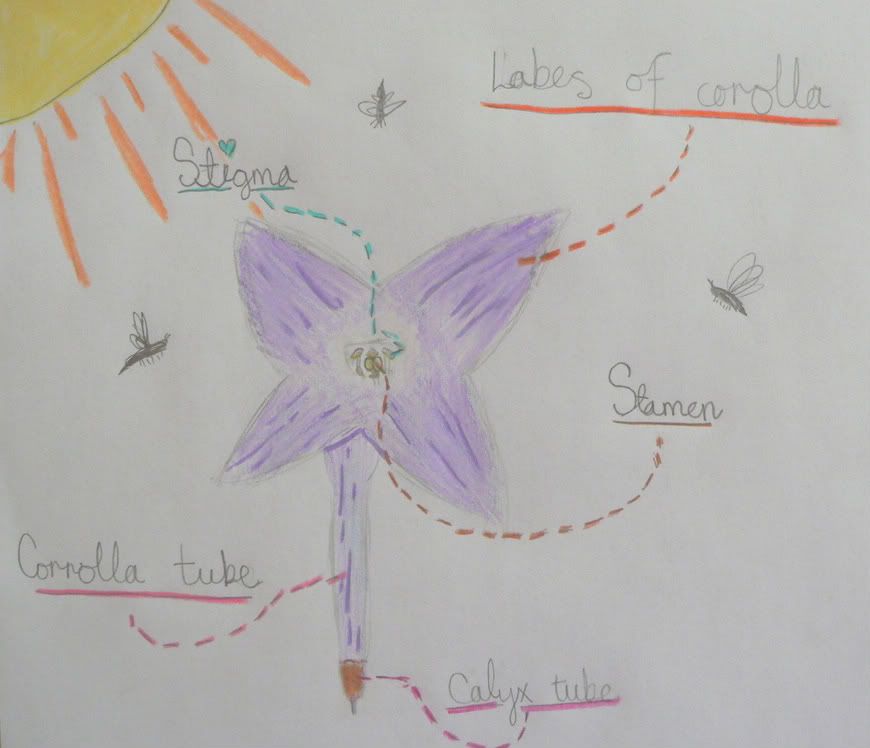From Our Nature Notebook: Flower Power
This week our nature study focus has been flowers. I thought I would post how this nature study unit is being planned and a bit on how it's going.
Teacher Prep - The first thing I did as teacher background was read "How to Begin the Study of Plants and Flowers" by Anna Comstock (Handbook of Nature Study pp 453-460). Then I stopped by the library and picked up a few flower and plant-related books, field guides and magazines. The new June issue of Nature Friend magazine arrived (yay!!!) and I scanned it for flower-related articles and activities. (There were some!) I also marked the pressed flower project directions in my Nature Smart book.
Getting "Out There" Well, in this case, "out there" was in our backyard. : ) I announced that we were going to be finding some flowers to look at and press. Immediately, Miss M excitedly scampered out into our back yard to collect some fragrant lilacs. When she came back in she had a crown of lilacs and plenty of specimens to press.

Informal Lesson With my Handbook of Nature Study and Eyewitness Plant open, we each took one of the small lilac flowers collected and found some the parts listed in the Handbook on p. 456 - lobes of corolla, corolla tube, calyx lobes, calyx tube, stamen, and sepal. We looked at the beautiful pages entitled "A simple flower dissected" (pp 16-17) in Eyewitness Plant. After learning the parts of the lilac flower and discussing their functions, Miss M made a drawing for her notebook, labeling some of the parts.

Expand From here Miss M may press more flowers and make notecards and candles with them, using the directions in Nature Smart. We plan to make it to our local floral shop to see, smell, and compare different flowers. Adding to the nature notebook by identifying and drawing 3 or 4 local flowers and reading some books and articles will round out our Flower Power focus. I hope to do a few of Anna Comstock-style observation lessons with whatever flowers Miss M decides to identify. Using the Handbook makes it pretty easy, even though I'm not a botanist or even a gardener!

Art will be the flower illustrations, and maybe a sketch from the Draw 50 book. For Practical Life, we also plan to try our hand at flower arranging using some cheap, grocery store flowers mixed with backyard flowers and weeds and possibly try some edible flowers.
Resources Used
Here are some basic books we found at the library:
- Eyewitness Plants
- Eyewitness Explorers: Flowers
- Flowering Plants by Wendy Madgwick
- A Golden Guide: Flowers
- A state Horticulture Society magazine
- Draw 50 Flowers, Trees, and Other Plants by Ames
Here are the books on my shelf:
- Handbook of Nature Study by Anna Comstock
- Nature Smart: Awesome Projects to Make With "Mother Nature's" Help
- Nature Friend magazine, June 2008 issue
I will close with a sample lesson from Handbook of Nature Study. As you can see, this handbook is easy to use, practical, and just as useful today as when it was printed in the early 1900's. This method could be modified to use with any flower in YOUR backyard. : )
LESSON 120 THE TRILLIUM
LEADING THOUGHT The trilliums are
lilies, and are often called wood lilies, be-
cause of their favorite haunts. There are
several species, but they are all alike in
that they have three sepals, three petals,
and three leaves.
METHOD This lesson may be given
from trilliums observed in the woods by
the pupils, who should be encouraged to
watch the development of the berry and
also to learn all the different species com-
mon to a locality.
OBSERVATIONS
1. How many leaves
has the trillium? How are they arranged?
Draw a leaf, showing its shape and veins.
Describe the stem of the plant below the
leaves, giving the length and color.
2. How far above the leaves does the
flowerstalk or peduncle extend? Does the
flower stand upright or droop? Describe or
sketch the colors, shape, and arrangement
of the petals and sepals. Do the petals
have raffled margins?
3. Describe the pistil and the stigmas.
Describe the stamens and how they are
placed in relation to the pistil.
4. Do the flowers remain open during
cloudy days and nights?
5. What insects do you find visiting the
trilliums? Do the same insects visit the
purple and the white trilliums? What is
the difference in odor between the purple
and the white trillium? Does this seem
to bring different kinds of insects to each?
6. How does the color of the white tril-
lium change as the blossom matures?
What is the color and shape of the fruit
of each different species of trillium?
When is the fruit ripe?











 >
>
4 comments:
Neat! This (along with Barb's Handbook of Nature Study blog) is inspiring me to get my hands on the Anna Comstock book and reminding me to subscribe to the Nature's Friend magazine!
Stacy :-)
Very nicely done my friend! She did a wonderful drawing. :)
I am soooooooooo wanting that magazine!
Have a wonderful weekend!
~Tina
Hello there - found your site through the yahoo TQ group site. What a treasure you have here! As a former Sonlighter - who is now onto a CM style with a stronger Biblical Worldview - your schedules were so helpful to me. I just enjoyed everything I read and was so encouraged by your blog. Have a blessed summer and thank you very much for sharing! HV
So, when you've completed Miss M's education, how about the 2 of you open a day school? I'll still have little ones young enough to attend! :)
Lee
Post a Comment